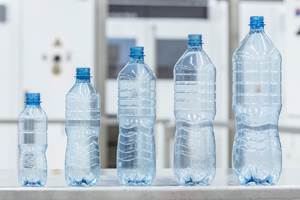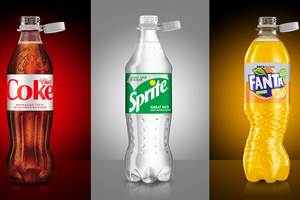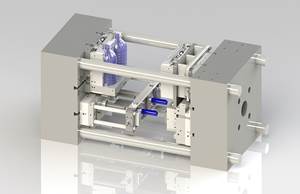On-Line PET Bottle Thickness Gauging Brings Responsive Process Control
Maintaining desired wall thickness in the neck, shoulder, wall, and base of a PET bottle is a continuing challenge to blow molders, says Chris Robinson, head of quality assurance at the Bowling Green, Ohio, plant of Southeastern Container (SEC) Group Inc.
Maintaining desired wall thickness in the neck, shoulder, wall, and base of a PET bottle is a continuing challenge to blow molders, says Chris Robinson, head of quality assurance at the Bowling Green, Ohio, plant of Southeastern Container (SEC) Group Inc. "Most bottle problems are thickness related," says Robinson. A choke neck, pearl feet, or thin sidewall are common areas of concern. "Several variables go into blowing the bottle, including heat, humidity, preform quality, resin quality, and machine set-up," adds Tim Atkinson, maintenance-team coach at the plant. To keep all these variables under control, the molder needs real-time information about the material distribution in the bottles coming out of the machine. But until recently, no system was available to provide such data.
Until the arrival of a dramatically new type of QC instrument, SEC had to be satisfied with off-line checks on sample bottles from each hour's production. SEC cut up the bottles and weighed sections as an indirect measure of wall thickness. That approach did not permit timely adjustments of SEC's Sidel reheat stretch-blow machines, each of which puts out several tens of thousands of bottles per hour. "Any bottle-quality issues could find its way into a whole hour's worth of production," says Robinson. For SEC Group, a seven-plant cooperative that makes PET containers exclusively for Coca-Cola bottlers, product uniformity is critical.
A solution to this problem comes from Agr*TopWave LLC, Butler, Pa., which has introduced the first device for measuring wall-thickness in-line with high-speed PET bottle production. The company's new PETWall instrument checks each and every bottle as it comes out of the molding machine, says David A. Dineff, product marketing director for Agr*TopWave. On a dual-outfeed machine, the device uses two infrared sensors on each outfeed to measure two points on the bottle. With a single outfeed, PETWall can accommodate four sensors for four thickness readings per bottle. Readings are taken within 0.2 sec or less, so the device can handle up to 30,000 bottles/hr per outfeed. Measurement accuracy is said to be 0.001 in.
"The unit can identify process trends before they become production problems, reducing the reaction time for detection, determining the cause, and adjusting the blow molding unit to solve the problems," says Robinson. Operators use the readings from PETWall to adjust heating zones in the molding machine. The system has been commercial since May and is priced under $75,000 depending on system set-up.
Real-time inspection
PETWall consists of an infrared light panel and cylindrical sensing head. The unit measures ir absorption as the light passes horizontally through a section of the bottle. The system's processor translates that information into an average wall-thickness measurement.
The system can measure a bottle with up to 5 in. diam, which corresponds to a typical three-liter bottle. SEC configured its two-liter bottle line so that the output is split into two take-off streams. Each outfeed is set up with two sensor heads that look at the neck and foot of each bottle.
The operator programs the desired wall-thickness control limits into the free-standing operator interface. The flat-panel monitor displays a graphical rendering of the bottle, showing the positions of the sensors taking the measurement. Thickness measurements that are within the preset upper and lower control limits are shown in green. Wall thicknesses that are not as good but still acceptable are indicated in yellow, while unacceptable wall thicknesses are shown in red. That way, the operator gets a quick visual indication of the wall thickness readings from each sensor. The operator knows immediately when to adjust heating zones and also sees right away the results of those process changes. PETWall also provides a one-minute average chart of upper and lower control limits, so that an operator can see if the process is trending out of control. "This is where the system goes beyond inspection and sorting out bad bottles, giving the operator enough information on the product that correlates with what is happening inside the blow molding unit," says Atkinson. Robinson notes that SEC also performs visual checks for bottle defects and contamination at least once every hour.
Since July, SEC has had PETWall systems installed on its machine making two-liter bottles. SEC produces clear and green packages on that line and finds that bottle color makes no difference. The company is now setting PETWall up on a second line that will make 20-oz bottles.
Related Content
First Water Bottles With Ultrathin Glass Coating
Long used for sensitive juices and carbonated soft drinks, KHS Freshsafe PET Plasmax vapor-deposited glass coating is now providing freshness and flavor protection for PET mineral water bottles.
Read MoreCoca-Cola Europacific Transitions to Tethered Caps and Lighter PET Bottle
Sidel is converting all Coca-Cola PET bottling lines in Europe to meet new EU packaging regulations by July 2024.
Read MoreFor Extrusion and Injection-Blow Molders, Numerous Upgrades in Machines and Services
Uniloy is revising its machinery lines across the board and strengthening after-sales services in tooling maintenance, spare parts and tech service.
Read MoreAt NPE, Cypet to Show Latest Achievements in Large PET Containers
Maker of one-stage ISBM machines will show off new sizes and styles of handled and stackable PET containers, including novel interlocking products.
Read MoreRead Next
Making the Circular Economy a Reality
Driven by brand owner demands and new worldwide legislation, the entire supply chain is working toward the shift to circularity, with some evidence the circular economy has already begun.
Read MoreSee Recyclers Close the Loop on Trade Show Production Scrap at NPE2024
A collaboration between show organizer PLASTICS, recycler CPR and size reduction experts WEIMA and Conair recovered and recycled all production scrap at NPE2024.
Read More















